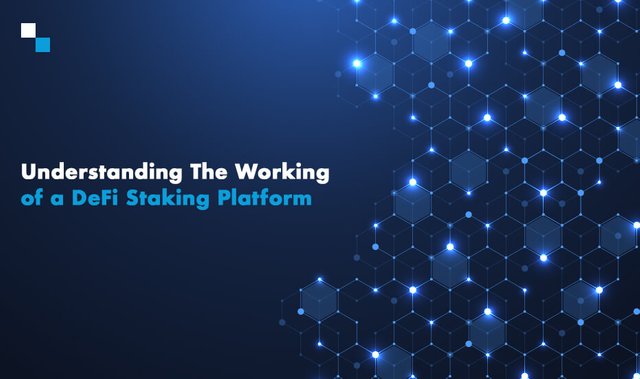
DeFi staking, in its most narrow definition, refers to the practice of locking crypto assets into a smart contract in exchange for becoming a validator in a DeFi protocol or a Layer 1 blockchain and earning rewards for performing the duties the role requires. More broadly, DeFi staking is often used as a collective term for all DeFi activities that require temporary commitment of crypto assets.
In the following paragraphs, we’ll be taking a closer look at staking and two other popular forms of DeFi investing – yield farming and liquidity mining. We’ll try to identify the subtle and not so subtle differences between them, as well as the biggest challenges that the nascent DeFi sector currently faces. Let’s get started.
Types of DeFi staking
Staking
As mentioned above, the purest form of staking involves locking a set amount of crypto assets to become a validator in a Proof-of-Stake (PoS) blockchain network.
Unlike Proof of Work consensus algorithms, where ensuring transaction validity requires a lot of energy-intensive computational work, PoS relies on validators that have vested interest in the success of a network through their staked crypto assets. In other words, validators have to perform their duties diligently, otherwise they face the risk of losing a portion or even the entirety of their stakes. In addition, validators are eligible to receive staking rewards for creating and validating blocks, which further incentivizes good behavior.
Undoubtedly, the most high-profile PoS blockchain currently is Ethereum, which is transitioning from Proof of Work to Proof of Stake as part of the eth2 (Ethereum 2.0) project. Other notable examples include Polkadot and The Graph.
At its most basic level, the staking process boils down to an interested party posting a ‘bond’ (stake) to become a network validator, which in turn makes that party eligible for staking rewards. The problem with this direct approach to staking is that the stake requirement is often quite high. For example, to become a validator on eth2’s Beacon Chain, you need to post a 32 ETH, which is a hefty investment. Because of this, most individual investors are typically priced out of staking opportunities.
Fortunately, there has been an emergence of staking service providers that allow people to circumvent the steep financial requirement. First, we have the so called staking pools, which allow people to join forces with other crypto investors in order to raise staking capital. The system enables people to deposit any amount of tokens to a staking pool and start earning passive income based on how much of the pool’s total holdings their deposit accounts for.
Alternatively, users can also turn to a crypto exchange, since most major centralized and decentralized exchanges offer DeFi staking services.
Yield farming
While lending and borrowing platforms provided the first strong use case for decentralized finance, the advent of yield farming showcased DeFi’s true power. The term refers to the practice of moving crypto assets between multiple Defi staking platforms to maximize returns. Essentially, people make their assets available to a lending protocol or a liquidity pool and they earn passive income in the form of interest, as well as a percentage of the revenue generated by their platform of choice. However, they can easily redirect their assets to other pools and platforms to chase more lucrative rates of return.
Of course, investing in different assets with the idea to maximize your earning potential or hedge against unexpected risks is one of the central investing strategies in traditional financial markets, as well. However, DeFi staking enables never-before-seen flexibility, as the combination of 24/7 access to markets, smart-contract-driven automation and lack of intermediaries allows for investors to jiggle between multiple DeFi protocols with little to no downtime. Such a level of flexibility creates plentiful opportunities for forming various DeFi staking strategies.
Liquidity mining
Liquidity mining is a subcategory of yield farming that involves providing crypto assets to liquidity pools. These pools are crucial for enabling trading without intermediaries on the type of decentralized crypto exchanges (DEX) known as auto market maker (AMM). A typical liquidity pool consists of the two assets that make up a particular trading pair – for example ETH/DAI – and utilizes an algorithm to ensure that the value of one of the assets is always equal to the value of the other. This means that the pool dynamically adjusts the prices of the assets to account for any changes in their respective values that might have occurred as a result of trades. To put it in the context of our ETH/DAI example, a purchase of ETH would decrease the amount of ETH in the pool, while increasing the amount of DAI. To counter this, the pool increases the price of ETH relative to DAI.
At its core, this whole system relies on liquidity providers who make their assets available to liquidity pools. For that, liquidity providers can receive various financial incentives, including a percentage of the fees collected by the pool. Some DeFi staking platforms also include their own tokens in their reward programs. As we’ll see below, DeFi protocols need to have robust reward programs in order to make staking economically viable for liquidity providers.
Drawbacks of DeFi staking
While it has some significant advantages over traditional investing, there are also some drawbacks to DeFi staking that have to be noted. The main one is the so called ‘impermanent loss’, which occurs in the process of liquidity mining.
Impermanent loss
Because the price-adjusting algorithms of liquidity pools are only concerned with maintaining a balance between the values of the assets within a pool, the same tokens can have different values within and outside of a liquidity pool. Because of this, taking your tokens out of a pool comes at a loss. Staking reward programs are meant to counter this phenomenon and make sure that liquidity providers are compensated for their efforts.
Gas prices
Another drawback stems from the limited scalability of the current generation of Layer 1 blockchains, particularly Ethereum, which is home to the majority of today’s most popular DeFi protocols. The scalability problem often leads to gas price hikes, which makes DeFi activities quite pricey. Here the hopes of finding a viable solution to the problem lie with Ethereum 2.0, as well as a host of Layer 2 solutions, including rollups. One of the most popular DeFi protocols, Uniswap, was recently deployed to two of the most prominent rollup solutions currently on the market – Optimism and Arbitrum.

Conclusion
The aforementioned drawbacks reflect the fact that DeFi is still a novel concept that needs to be further developed and fleshed out. There are still some challenges that need to be addressed, especially given the fact that blockchain technology, in general, is still far from mature. Yet, even at this early stage, DeFi staking has shown that it has great potential and could provide a viable alternative to traditional investing.